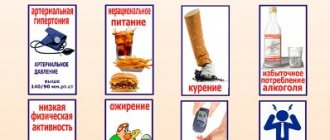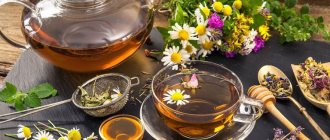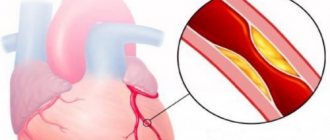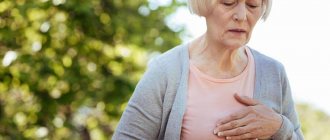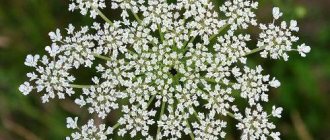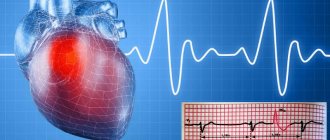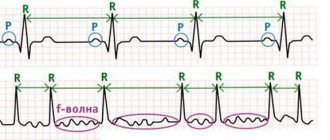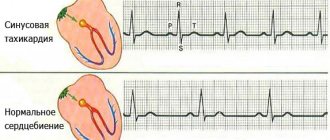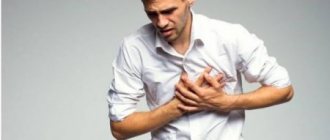Causes of angina development
At the initial stage of development of coronary insufficiency, angina appears quite rarely, provoked by severe physical exertion or stress. But over time, the frequency of attacks begins to increase as their duration increases. When the disease becomes severe, pain occurs even at rest.
The danger of the disease is that it can provoke the development of myocardial infarction. Therefore, its symptoms should never be ignored.
Before you begin treating angina with the most effective traditional methods, it is necessary to understand the mechanisms of development of the disease. This pathology can manifest itself for two types of reasons:
- immutable, which cannot be eliminated;
- modifiable, which can be eliminated, avoiding the development of the disease.
The unchangeable factors are:
- Age. If previously it was believed that people aged 50-60 years were at risk for this disease, today the pathology is detected in people under forty years of age. If constant stressful situations and nervous tension occur, ischemia and subsequent infarction of the heart muscle can develop in twenty-year-old people.
- Hereditary. If close relatives of the patient suffered from this disease, then it is highly likely that he will develop it too. Angina pectoris very often occurs as a result of previous chronic diseases - these are heart defects, rapid heartbeat, and heart attack.
Variable causes of the disease are as follows:
- Lack of normal physical activity. Due to numerous tests, scientists were able to establish that the more training the myocardium endures, the less likely it is to develop this disease.
- Poor nutrition, namely, consumption of smoked, salted, fried, and other heavy foods, not only worsens the functionality of the cardiovascular and digestive systems, but also negatively affects the functioning of the entire body as a whole.
- Alcohol and smoking abuse. If you have heart problems, you need to give up these bad habits.
- Obesity. If you have a small amount of excess weight, a balanced diet and exercise will help you correct it. If the patient’s weight significantly exceeds the norm, then complex treatment methods should be used to prevent angina pectoris.
- Hypertension. The development of the disease has an extremely negative impact on the condition of the blood vessels. Prevention of the disease involves a balanced diet, increased physical activity, and quitting smoking and alcohol. All this is accompanied by appropriate drug treatment.
- Stress. Scientists believe that happy, optimistic people are least likely to develop angina. Those at risk include people with a depressive character and those experiencing serious emotional upheaval and nervous tension.
- Chronic diseases. Some diseases can negatively affect the cardiovascular system. The development of angina pectoris can occur as a result of diabetes mellitus.
To prevent the disease, it is very important to maintain a healthy lifestyle. We are talking about moderate physical activity, diet, sleep patterns and giving up bad habits.
Lifestyle
When the first signs of angina appear, it is necessary to change your lifestyle.
There are certain recommendations that must be followed for this disease:
- Physical activity of moderate intensity. This could include exercise in the morning, walking, walking before bed - preferably at least an hour a day. You can ride a bicycle, but only on a flat surface, not uphill.
- Maximum exclusion of stressful situations.
- Performing breathing exercises.
If you have angina pectoris, you must stop smoking, and not only not smoke, but also not be in the company of people who smoke. Strong physical activity is contraindicated, as is a sedentary lifestyle.
In addition, if you have previously taken hormonal medications, you should consult your doctor and choose a replacement, since their use for angina pectoris is not advisable.
If you are wondering whether angina can be cured completely, the answer is definitely yes, but only with a combination of treatment, diet and the right lifestyle.
Symptoms of the disease and factors that cause pain
Angina pectoris is manifested by discomfort and pain in the chest. Most often the pain is of a squeezing or pressing nature. They are localized inside the chest and can radiate to the neck, left side of the lower jaw or arm. Pain occurs suddenly, lasting from several minutes to an hour. This may be accompanied by the appearance of cold sweat on the patient's forehead.
The manifestation of the disease most often occurs due to stress or physical strain. The main factors provoking pain are:
- physical activity (running or brisk walking, lifting weights, climbing stairs, etc.);
- stress;
- hypothermia;
- high blood pressure;
- binge eating.
Most often, the pain goes away within 3-5 minutes if the person is at rest. Nitroglycerin allows you to quickly relieve pain.
Pain relief
Treatment of angina pectoris begins with the ability to eliminate the pain attack. The duration of the attack is usually no more than five minutes, but if measures are not taken in time, angina attacks can cause the development of myocardial infarction.
In the event of an attack, you must:
| Sit down or, if there is nowhere to sit, lean on something and remain completely calm |
|
| Place a Nitroglycerin tablet under your tongue |
|
| Seek advice from a specialist | If an attack of angina occurs for the first time, or accompanying symptoms appear, such as dizziness, shortness of breath, then it is necessary to consult a specialist, as this may be evidence of progression of the disease. |
The use of honey for angina pectoris
If you are interested in how to treat angina pectoris at home, you should pay attention to honey-based recipes. This substance is an important source of microelements that have a positive effect on the functioning of the heart muscle. This product helps improve coronary blood supply, and the vitamin C it contains is responsible for the elasticity of blood vessels. One of the main components of honey is potassium, which normalizes heart rate.
A number of medicines are made from honey to treat diseases of this organ. One of the most famous is “Todikamp”, which contains honey extract and walnuts.
The most common recipe for treating illness with honey involves the following steps:
- 1 kg of lemons are ground through a meat grinder without removing the zest.
- 10 medium-sized heads of garlic are peeled and crushed.
- Add a kilogram of honey to the resulting mixture.
- The composition is mixed well and sent to a dark place for a week.
The medication should be taken one teaspoon at a time, 4 times a day. Before swallowing, keep the mixture in your mouth for a couple of minutes. You should be treated in this way for two months.
If angina pectoris does not cause severe pain, then a good way to combat the disease is a medicine based on honey with grated horseradish. Containing a large number of essential oils and glycosides, the latter helps improve blood circulation, dilates blood vessels and lowers blood pressure. The cooking method is as follows:
- Grate horseradish on a fine grater.
- One part of the plant should contain 4 parts of honey.
- The product does not require infusion and can be used immediately after preparation. Take a teaspoon twice a day for four weeks.
Any heart pathology can be cured with a remedy based on honey, lemon and dried fruits. With long-term use, heart rate and blood pressure normalize, and immunity improves. It is very simple to prepare the medicine at home:
- Grind raisins, prunes, dried apricots and walnuts (200 g each) in a blender.
- Add 200 ml of honey to the resulting mass.
- Grind a medium lemon along with the zest, after removing the seeds. You can also simply squeeze lemon juice into a mixture of dried fruits and honey. Take a tablespoon before meals three times a day.
No less effective is combining honey with aloe. This plant acts as a natural biostimulant, which can effectively eliminate ischemia in cardiac tissues, helping to increase the elasticity of blood vessels. The mixture is prepared as follows:
- 5 leaves are cut from the plant. It is necessary to select large lower leaves of a flower that is more than three years old.
- The leaves are peeled, after which the juice is squeezed out of them through cheesecloth.
- To the resulting juice you need to add 500 g of honey and 2 chopped lemons.
- The product must be placed in the refrigerator for three hours. Take a tablespoon three times a day an hour before meals. The intake is carried out for a month, then the same period is a break with the use of another folk remedy. The course of treatment is one year.
Pills
Drug treatment of angina pectoris is carried out depending on the stage of the disease.
At the initial stage of the disease, drugs used during an attack (Nitroglycerin) and drugs aimed at improving fat metabolism are prescribed.
In more serious stages of the disease, medications are prescribed to improve the functioning of the heart muscle and improve blood quality.
Treatment of angina pectoris is carried out in several directions:
| Antiplatelet therapy | Aimed at preventing thrombosis, which is one of the main causes of heart attack. Therapy includes two types of drugs:
Non-steroidal anti-inflammatory drugs include Aspirin and other drugs containing acetylsalicylic acid. Their action is based on thinning the blood, preventing the formation of blood clots and their adhesion to the walls of blood vessels. Antiplatelet agents that prevent the formation of blood clots by blocking platelet receptors include Ticlopidine, Tiklid, Clopidogrel, Plavix. |
| Anti-ischemic therapy | Aimed at reducing the load on the heart. Anti-ischemic therapy also includes four types of drugs:
Nitrates include drugs such as Nitroglycerin, Isosorbide dinitrate, Isoket, Aerosonit, Isosorbide mononitrate, Isomonate, Monizide, Mono Mac. Other drugs include Molsidomine. β-blockers include Propranolol, Atenolol, Bisoprolol. Slow calcium channel blockers include Verapamil, Nifedipine, Diltiazem. |
| Improving metabolism in the ischemic zone | In this direction, drugs called Cytoprotectors are used and are aimed at increasing myocardial stability. These are Riboxin and Trimetazidine. |
| Correction of fat metabolism, preventing atherosclerosis | This type of therapy includes three types of drugs:
|
Herbal infusions
A competent combination of medicinal herbs can cure almost any ailment. Herbal preparations are also used in the treatment of angina pectoris with folk remedies. The following traditional methods are highly effective in treating the disease:
- Tricolor violet flowers are brewed in the following proportion: a teaspoon per 250 g of water. This remedy can be used during exacerbation of the disease.
- Sunflower decoction. Well-dried flowers are used for the product. A glass of petals is poured with a liter of water, then they should be boiled for five minutes. After this, the broth is infused for an hour, filtered and consumed three times a day, half a glass.
- A decoction of hawthorn inflorescences. Pour 2 tablespoons of flowers into a container and add a glass of water. After this, boil for 7 minutes, filter and consume 50 ml three times a day.
- Rosehip based product. Take 10 tablespoons of hawthorn and 5 tablespoons of rose hips. The berries are mixed and crushed. This mixture is poured into 2 liters of boiling water. Next, the container is wrapped and infused for 24 hours in a warm place, then filtered. Drink 200 ml infusion three times a day before meals. This remedy can be used in the fight against all heart ailments.
- Remedy made from cornflower and mustard. Pour a teaspoon of mustard powder and two tablespoons of cornflower herb into a container. Mix well and pour a glass of boiling water. Next, the product is infused for two hours and filtered. You should take a tablespoon three times a day.
- Field toad and mustard. Mix 2 tablespoons of toad grass with mustard seed powder (1 teaspoon). Pour the mixture with two glasses of water, then boil for 30 minutes and immediately filter. A tablespoon of decoction should be taken 6 times a day.
- St. John's wort infusion. Take two tablespoons of dry raw materials per glass of boiling water and leave for an hour. Filter and take a quarter glass three times a day.
- Motherwort infusion. Two teaspoons of dried herb are poured into 0.5 liters of boiling water, then you need to send the product to a dark place for 8 hours. Take 50 ml four times a day.
- Hawthorn infusion. For seven tablespoons of dry herb there are 7 glasses of hot water. The container is wrapped and placed in a warm place for a day. After this, the infusion should be filtered and taken a glass three times a day. The infusion retains its positive properties when stored in a cool and dark place.
Diet
In the treatment of angina pectoris, one of the main places is occupied by proper nutrition, aimed at improving metabolism. Treatment of angina by fasting is prohibited, since in this case the body does not receive much needed vitamins and minerals.
There are products that are extremely useful for this disease:
| Cereals | Almost all types of cereals are useful: wheat, rice, oatmeal, buckwheat, millet, barley. All of them contain a large amount of vitamins and minerals that regulate metabolism and prevent the appearance of cholesterol plaques on the walls of blood vessels. |
| Raisins and dried apricots | They contain a huge amount of magnesium and potassium, thanks to them they remove harmful substances from the body and support the functioning of the heart. |
| Fruits and vegetables | Fresh and steamed. Bananas and apricots are especially useful. |
| Sea kale | Containing a huge amount of substances beneficial to the body, such as iodine, sodium, phosphorus and folic acid. |
| Dairy | But not too greasy. |
| Fish and lean meats | Fatty fish such as mackerel and trout contain large amounts of omega acids necessary for the normal functioning of the body. In addition, meat and fish are sources of protein. |
| Honey | Is an excellent source of potassium. |
An important point is also sufficient water consumption - at least two liters per day.
Tinctures
Treatment of angina pectoris with folk remedies cannot be done without the use of all kinds of tinctures. A mandatory component of such products is vodka or alcohol. By interacting with medicinal herbs, moderate doses of alcohol contribute to the expansion and strengthening of blood vessels, relieving spasms and restoring proper blood supply to the myocardium. The following recipes are most popular among people:
- Alcohol tincture of Adonis stems. Mix 50 g of dried adonis with the same amount of three-leaf leaves. The mixture is poured with a liter of vodka, after which it must be infused for three weeks. After filtration, a single dose is 25 drops diluted in 50 ml of water.
- Hawthorn tincture. 10 g of dried berries are poured with 100 ml of vodka. The product is infused for 14 days in a dark place. After straining, the tincture is taken in the same way as in the recipe described above.
- Tincture based on elecampane root. 30 g of dry raw material is poured with 0.5 liters of vodka and infused for two weeks. The product is filtered and completely ready for use. The average dose is 40 drops three times a day.
Treatment at the "Emergency" stage
The emergency doctor is usually interested in the medications taken. The ambulance has stronger painkillers in its arsenal to relieve an attack:
- coronary lytics that relieve spasm of the heart vessels (Papaverine, Platiphylline);
- narcotic analgesics (Morphine, Promedol, Omnopon).
They are administered subcutaneously in the absence of effect from nitroglycerin.
The cardiac team administers Droperidol and Fentanyl intravenously, and possibly short-term inhalation of nitrous oxide.
In case of a prolonged and severe attack of angina, the patient is hospitalized in a hospital.
Combined folk recipes
Effective treatment of angina at home involves the use of remedies that combine the preparation methods described above. The most popular among them are:
- 500 g of honey is poured into 0.5 liters of vodka and heated on the stove until a homogeneous mass is obtained. The mixture is then cooled. At the same time, you need to boil a liter of water, after which it is poured with a mixture of knotweed herbs, valerian root, marsh grass, chamomile and motherwort (you need to take a tablespoon of each herb). Leave for exactly one hour, after which the previously prepared mixture is poured into the infusion and mixed. The final product must be kept in a dark place for a week. Take a tablespoon twice a day.
- Squeeze the juice from the garlic head (large), add a glass of Cahors and half a teaspoon of salt. Take a tablespoon at night. The course of treatment is a month. Over the course of a year, you need to carry out two courses of treatment for angina pectoris at home.
The high effectiveness of traditional methods in the treatment of heart diseases has been proven more than once in practice. This is evidenced by numerous positive reviews about the treatment of angina pectoris with folk remedies. But the best result is ensured if the use of infusions, tinctures and herbal preparations is combined with taking tablets prescribed by a specialist.
Before treating angina pectoris with folk remedies, you need to have an accurate diagnosis. Therefore, you should not self-medicate - in case of any interruptions in the functioning of the heart, you must contact a specialist who will diagnose and determine the further course of treatment. Only in this way can you finally get rid of the disease.
Treatment tactics and objectives
The latest recommendations of the European Society of Cardiology (2013) define two main goals in treatment:
- pain relief;
- reduction of the area of myocardial ischemia.
Both tasks directly affect the prognosis and life expectancy of patients.
If symptoms of angina pectoris appear, it is recommended:
- give up smoking, alcoholic drinks, strong coffee;
- switch to a diet limiting animal fats (fatty meat, sour cream, cream, lard, butter) and easily digestible carbohydrates (sweets, baked goods);
- reduce physical activity to moderate, force yourself to move more, do exercises;
- If you are overweight, do low-calorie fasting days;
- engage in auto-training, yoga, suitable calming procedures to normalize sleep and improve tolerance to stressful situations.
The patient must draw up a realistic plan of action and strictly adhere to its provisions. Treatment at different stages is carried out using different methods.
Physiotherapy
A complex of exercise therapy for angina pectoris should be selected individually by a doctor, taking into account the latest tests, ECG data and clinical symptoms.
For mild angina, it is recommended to do arm raises, slow turns and bends of the torso, and leg lifts while sitting on a chair. With frequent attacks, a period of bed rest follows, then dosed walking.
Breathing exercises “teach” the myocardium to cope with less oxygen, help improve ventilation, and relieve the hypoxic state. It is recommended to breathe deeply 2 – 3 times a day, observing the following rules:
- the room should be well ventilated, it is better to practice outside;
- inhale through your nose for a count of 1 to 3, then hold your breath for a count of 1, 2 and slowly exhale through your mouth for a count of five;
- When exhaling, it is recommended to “beat” yourself on the chest with light movements.
Treatment in outpatient settings
After discharge from the hospital, the patient is recommended medications that prevent attacks of angina and slow down the development of atherosclerosis in the vessels of the heart.
- Therapy with one or two drugs (first and second line) continues. Curantil is prescribed to normalize blood viscosity and prevent thrombosis.
- A drug from the statin group is selected according to indications.
The combination of angina pectoris with hypertension, diabetes mellitus, heart failure, rhythm and conduction disturbances requires very careful dosage selection for the elderly. You shouldn't give them your pills. Even good products can be overly effective.
- Mercazolil and Methylthiouracil contain thyroid hormones, delay the development of atherosclerosis and dilate blood vessels, and are used in courses in small dosages.
- Combined action agents include Corontin, Falikor, Intencordin.
- Under the control of a coagulogram, long-term use of modern aspirin anticoagulants is recommended.
- To normalize metabolic processes in the heart muscle, a course of taking Potassium orotate, Panangin or Asparkam, B vitamins with folic acid is indicated, and nicotinic acid is prescribed by injection.
Other treatments
To cure angina pectoris, it is recommended to conduct a course of sanatorium-resort treatment in a familiar climate zone. You should not strive for resorts of republican significance. With climate change, attacks may become more frequent.
In each region there are rehabilitation departments and sanatorium-type centers. They offer treatment at the expense of the compulsory health insurance fund (free for the patient) and with additional paid services for nutrition and therapy.
The standards include all necessary medications, massage, exercise therapy, balneological treatment (baths, showers), and the use of auto-training.
Briefly about pathology
Angina is a syndrome that is accompanied by a feeling of squeezing, burning, and pain in the chest. Occurs against the background of heart and vascular diseases. For example, coronary disease, arrhythmia.
It mainly appears in patients over 45 years of age whose work involves excessive physical exertion. The disorder also occurs in people with mental disorders and diseases of the central nervous system.
Pathology can occur against the background of complications during pregnancy, due to hormonal changes. The acute phase of the disease is considered a pre-infarction state. This is due to the fact that it appears due to vasospasm or blockage by blood clots and cholesterol.
At the first symptoms, a person needs emergency medical care. This will help prevent myocardial damage.
Therapeutic measures in a hospital setting
For drug treatment of angina pectoris in a hospital setting, drugs of different groups are used, in accordance with the standards of therapy. The pharmacological action is aimed at preventing attacks, relieving spasm of coronary vessels, reducing myocardial oxygen demand and normalizing metabolic processes in cells.
There are two groups of main medications for angina pectoris.
The first line is a group of β-blockers and agents that cause the closure of calcium channels (Obzidan, Inderal, Anaprilin). Indicated for monotherapy (single drug) or in combination with other drugs.
Second line - added to the first line drugs, but sometimes they themselves become the means of primary treatment. These include:
- extended action nitrates (like nitroglycerin, but last up to 12 hours) Sustak, Nitrosorbide, Nitranol, Erinit;
- inhibitors at the enzyme level - Chloracizine, Trimetazine, Nicorandil, Ivabradine;
- for stable angina, patients are prescribed drugs that reduce blood clotting (Thromb ass, Cardiomagnyl, Clopidogrel).
